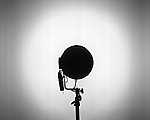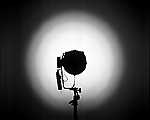How does your reflector attachment affect light?
If you wanted to create a pool of light, would you get a brighter result
using a honeycomb or a snoot p; and why? I can't say for sure, but this
might well be a question in a photography exam somewhere. What I can say,
however, is that very few people seem to know the proper differences between
snoots and honeycombs.
To answer the simple question first: honeycombs give brighter pools of
light than do snoots. The explanation why is equally simple. Snoots, being
conic in shape, have smaller exit pupils. In short, they act like lens diaphragms,
reducing the amount of light that passes through. This is an important point,
for some books make the mistake of claiming that snoots "concentrate"
the light p; when in fact they do no such thing. Nor do honeycombs concentrate
the light either: the only accessories to do that are (more expensive) optical
devices.
So what are the differences between snoots and honeycombs, other than the
fact that honeycombs are more efficient? Firstly, honeycombs give a much
cleaner illumination cut-off, with none of the spurious reflections that
tend to afflict snoots. Secondly, honeycombs can be fitted to larger reflectors,
giving larger directional light sources that still yield relatively soft
shadows within their areas of illumination. (The distinction between "soft"
and "hard" lighting seems to cause much confusion and is a topic
to which I will return at a future date.)
In the favour of snoots is the very fact that they ARE less efficient.
If a low level light is required, below the minimum power setting offered
on the unit itself, then fitting a snoot in place of a honeycomb will drop
the output by about two stops. It is then possible, by increasing the monobloc
power level, to get anything between the new minimum power provided by the
snoot and the lowest output on the light. A snoot therefore extends the
power range of a light to which it is fitted (which honeycombs do only to
a much lesser degree).
There is an important use for honeycombs (but not snoots) that arises in
connection with softboxes. It is perfectly possible to fit a large grid
over a softbox, keeping the softness of the large source but avoiding the
problem of excessive spill. Bowens has a lovely small softbox and rigid
honeycomb based on the Wafer 75, together with a larger version based on
the Wafer 100. Elinchrom has a rigid softbox that takes a honeycomb as well
as barn-doors, while Systems Imaging has a very nice collapsible ribbon
grid that is ideal for location work. The ability to light a foreground
softly, without degrading the background when the two are close together,
is highly recommended in all cases except when using just one light to perform
both functions!



Three b&w images showing comparative coverages and brightnesses of standard
reflector (left), snoot (centre) and honeycomb (right) accessories. The
examples were shot using a Systems Imaging 600J monobloc set to minimum
power and placed 1m from the back-drop. The standard reflector required
an aperture of 22.5, the honeycomb required 16.5, and the snoot required
8.5 p; all on Agfa Scala rated at an Exposure Index of 100.
- Jon Tarrant


